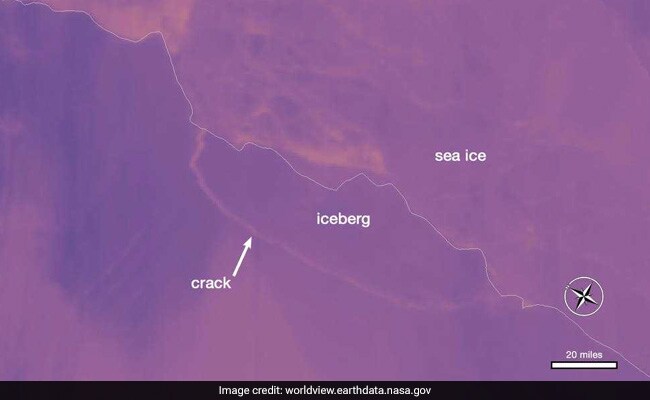
Snapshot of the rift in the Larsen C iceberg in Antarctica on Nov. 10, 2016.
Washington:
NASA released stunning dark images that show the movement of the trillion-tonne iceberg, one of the largest ever recorded - that recently broke off from Antarctica.
As Antarctica remains shrouded in darkness during the Southern Hemisphere winter, NASA's Thermal Infrared Sensor (TIRS) on Landsat 8 satellite captured a new snap of the 5,800 square kilometre iceberg that split off from the Antarctic Peninsula's Larsen C ice shelf on July 10-12.
The satellite imagery is a composite of Landsat 8 as it passed on July 14 and July 21 and shows that the main berg, A-68, has already lost several smaller pieces.
The A-68 iceberg is being carried by currents northward out of its embayment on the Larsen C ice shelf.
 The latest imagery also details a group of three small, not yet released icebergs at the north end of the embayment.
The latest imagery also details a group of three small, not yet released icebergs at the north end of the embayment.
The calving of the iceberg left the Larsen C Ice Shelf reduced in area by more than 12 per cent, and the landscape of the Antarctic Peninsula changed forever.
Icebergs calve from Antarctica all the time, but because this one is particularly large, its path across the ocean needs to be monitored as it could pose a hazard to maritime traffic.
As Antarctica remains shrouded in darkness during the Southern Hemisphere winter, NASA's Thermal Infrared Sensor (TIRS) on Landsat 8 satellite captured a new snap of the 5,800 square kilometre iceberg that split off from the Antarctic Peninsula's Larsen C ice shelf on July 10-12.
The satellite imagery is a composite of Landsat 8 as it passed on July 14 and July 21 and shows that the main berg, A-68, has already lost several smaller pieces.
The A-68 iceberg is being carried by currents northward out of its embayment on the Larsen C ice shelf.

Thermal wavelength image of a large iceberg, which has calved off the Larsen C ice shelf. The rift between the iceberg and the ice shelf appears as a thin line of slightly warmer area.
The calving of the iceberg left the Larsen C Ice Shelf reduced in area by more than 12 per cent, and the landscape of the Antarctic Peninsula changed forever.
Icebergs calve from Antarctica all the time, but because this one is particularly large, its path across the ocean needs to be monitored as it could pose a hazard to maritime traffic.
Track Latest News Live on NDTV.com and get news updates from India and around the world

